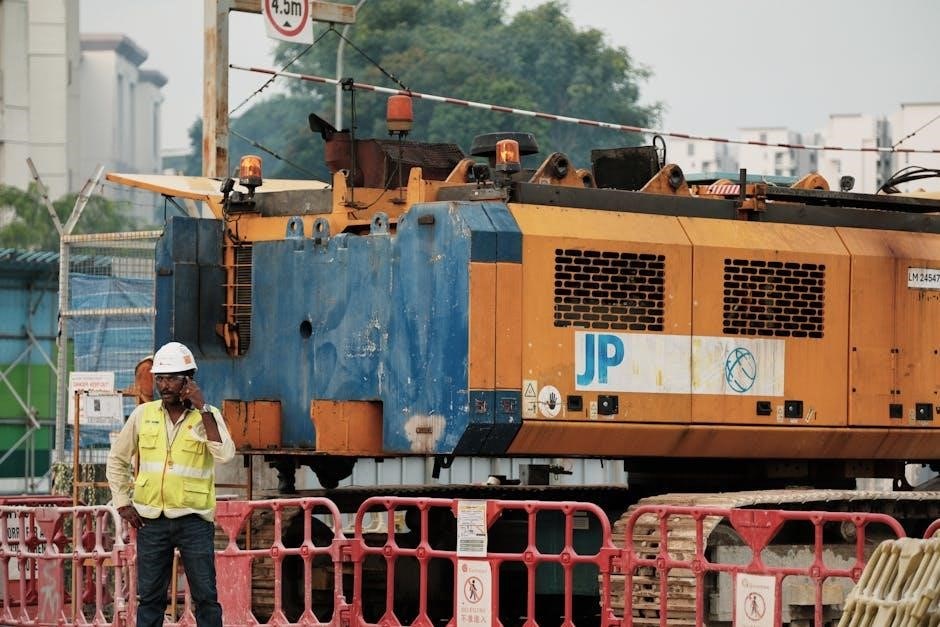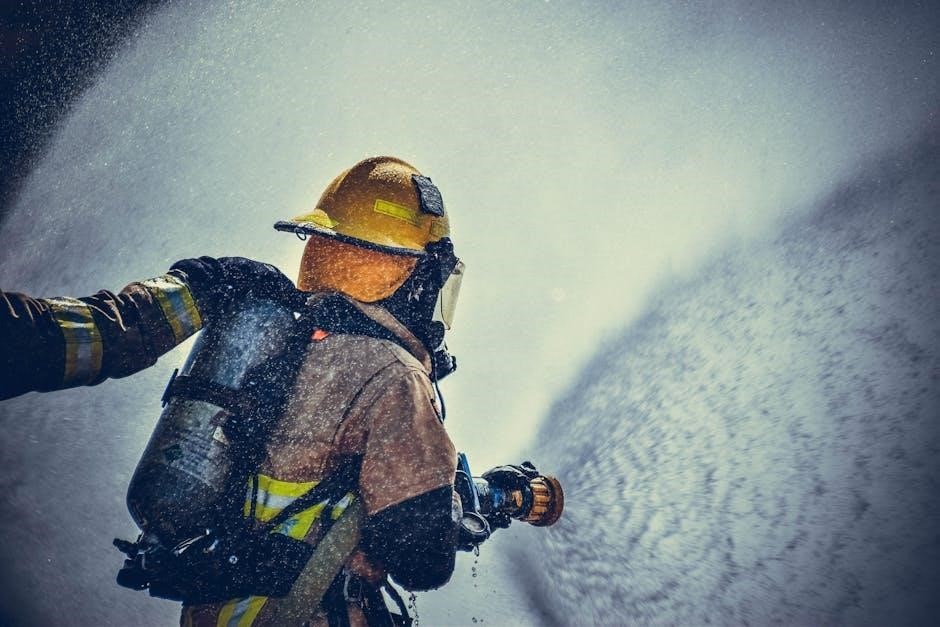Crane Safety Training Assessment PDF: A Comprehensive Guide
This comprehensive guide will provide insight into the realm of crane safety‚ covering the necessary regulations and standards. It includes inspection procedures and training protocols‚ all essential for a safe work environment. Crane safety knowledge is paramount.
Crane safety training is essential in construction and industrial settings‚ focusing on the safe operation and maintenance of cranes. This training is designed to reduce accidents and injuries involving cranes. It encompasses federal regulations‚ safety standards‚ and crane operation best practices. Crane safety training introduces participants to crane terminology‚ attachments‚ wire ropes‚ and load handling specifics.
Moreover‚ it covers load chart terminology and reading for different crane types. The training includes pre-operational inspections and safe shutdown procedures. Compliance with OSHA standards‚ like 1926.1400‚ is a vital component. Training programs often incorporate practical assessments to evaluate real-world crane operation skills. Proper training is critical for operators working with or around cranes‚ emphasizing hazard recognition and prevention to ensure a safe workplace.
Importance of Crane Safety Training
Crane safety training is paramount due to the inherent risks associated with crane operations‚ emphasizing accident prevention and workplace safety. Rigorous training equips operators with the necessary skills to handle cranes safely‚ minimizing the potential for equipment imbalances and collapses. By adhering to safety precautions and inspection procedures‚ operators can mitigate hazards effectively. Crane safety training also ensures compliance with OSHA standards‚ like 1926.1412‚ which are designed to protect workers and prevent accidents.
Effective training programs cover pre-operational inspections and safe shutdown procedures‚ critical for maintaining crane integrity. Furthermore‚ it promotes a culture of safety‚ encouraging operators to recognize and address potential hazards proactively. Through proper training‚ operators can prolong the life of the crane‚ preserve warranties‚ and foster a safer working environment‚ which ultimately benefits both the workers and the organization.

OSHA Requirements for Crane Safety
Meeting OSHA’s crane inspection requirements‚ as outlined in Standard 1926.1412‚ is essential. Compliance includes regular mobile crane standard inspections‚ ensuring safer crane operation. These requirements are vital for workplace safety and regulatory adherence.
OSHA 1926.1400 Compliance
Achieving OSHA 1926.1400 compliance is crucial for crane safety in construction. This standard outlines requirements for crane and derrick use‚ aiming to minimize risks and prevent accidents. Compliance involves various aspects‚ including crane inspections‚ operator qualifications‚ and safe operating procedures.
Employers must ensure that cranes meet all safety standards and that operators are properly trained and certified. Regular inspections‚ as detailed in the standard‚ are essential for identifying and addressing potential hazards. These inspections should cover structural components‚ mechanical systems‚ and control mechanisms.
Furthermore‚ the standard addresses specific requirements for different types of cranes and lifting operations. It also emphasizes the importance of load charts and proper rigging techniques. By adhering to OSHA 1926.1400‚ employers can create a safer work environment and reduce the likelihood of crane-related incidents. This compliance safeguards workers and promotes operational efficiency.
OSHA Crane Inspection Requirements (1926.1412)
OSHA 1926.1412 outlines the mandatory crane inspection requirements‚ crucial for maintaining safe crane operations. These regulations mandate regular inspections to identify and correct any deficiencies‚ ensuring crane integrity. Inspections must be conducted by competent individuals‚ trained to recognize potential hazards. The frequency of inspections varies‚ depending on crane usage and environmental conditions.
Daily inspections are required before each shift‚ focusing on essential components like wire ropes‚ brakes‚ and control systems. Monthly inspections involve a more thorough examination‚ documenting findings for future reference. Annual inspections are comprehensive‚ often requiring load testing and certification by qualified professionals.
Detailed records of all inspections must be maintained‚ including dates‚ findings‚ and corrective actions taken. These records serve as evidence of compliance and aid in tracking crane maintenance history. Adhering to OSHA 1926.1412 ensures that cranes operate safely‚ reducing the risk of accidents and protecting workers.
Key Components of Crane Safety Training
Crane safety training encompasses several crucial elements. These include best practices‚ rigging methods‚ and load handling. Comprehensive training ensures that operators understand safe operational procedures‚ minimizing risks and promoting a secure working environment for all.
Crane Operation Best Practices
Adhering to crane operation best practices is paramount for ensuring safety and efficiency on any worksite utilizing cranes. These practices encompass a range of procedures and guidelines designed to minimize risks and maximize productivity. One critical aspect is conducting thorough pre-operational inspections‚ verifying that all crane components are functioning correctly and that the surrounding environment is safe for operation.
Effective communication among crane operators‚ riggers‚ and ground personnel is also essential. Clear signals and protocols should be established and followed to prevent misunderstandings and potential accidents. Load weight determination is another crucial element; Operators must accurately calculate the weight of the load to be lifted and ensure that it does not exceed the crane’s rated capacity.
Furthermore‚ safe lifting techniques‚ such as smooth and controlled movements‚ are vital for maintaining stability and preventing load swings. Regular maintenance and adherence to manufacturer’s recommendations are also key components of crane operation best practices. By implementing these measures‚ companies can significantly reduce the risk of accidents‚ equipment failures‚ and injuries associated with crane operations.
Rigging Methods and Load Handling
Proper rigging methods and load handling techniques are crucial for safe crane operations. Selecting the appropriate rigging equipment‚ such as slings‚ shackles‚ and hooks‚ is paramount‚ ensuring they are in good condition and have the correct load capacity for the task. Riggers must be trained to inspect rigging hardware for defects before each use‚ replacing any worn or damaged components immediately.
Understanding load weight and center of gravity is essential for balanced and stable lifts. Loads should be rigged to distribute weight evenly‚ preventing tipping or instability during lifting. Clear communication between the rigger and crane operator is vital‚ using standardized hand signals or radio communication to coordinate movements.
Safe load handling includes avoiding sudden starts and stops‚ maintaining a safe distance from the load‚ and ensuring the load path is clear of obstructions. Rigging methods and load handling protocols should comply with OSHA standards and industry best practices. Regular training and competency assessments for riggers are necessary to maintain a high level of safety and prevent accidents related to improper rigging and load handling.

Crane Inspection Checklists
Crane inspection checklists are vital tools for ensuring crane safety and regulatory compliance. These checklists outline the necessary steps and criteria for assessing a crane’s condition‚ promoting safer operations by identifying potential hazards before they escalate.
Pre-Operational Crane Inspections
Prior to each shift‚ a thorough pre-operational crane inspection is paramount. This inspection‚ guided by a comprehensive checklist‚ helps identify potential safety hazards and equipment malfunctions before operation begins. The checklist should encompass structural parts‚ mechanical‚ and electrical systems. Control systems and the operator’s station need close scrutiny.
Examine load indicators‚ electrical wiring‚ and power sources meticulously. Check locking devices‚ gears‚ and brake systems for proper function. Any signs of damage or wear warrant immediate attention. Verify that all safety equipment is present and in use. Confirm the serial number on the load chart matches the crane.
Assess the ground for stability and levelness‚ ensuring it can support the crane’s weight. The operator should determine the load’s weight and the crane’s rated capacity‚ consulting the manual if needed. Document the inspection meticulously‚ noting any deficiencies for prompt corrective action. Proper execution is key to preventing incidents.
Mobile Crane Inspection Checklist
A mobile crane inspection checklist is a structured document outlining the necessary steps to assess a mobile crane’s condition and safety. It ensures compliance with OSHA 1926.1400 requirements‚ covering shift‚ monthly‚ and annual inspections. The checklist should include engine oil levels‚ hydraulic systems‚ and wire ropes.
Inspect the crane’s structural components for any signs of damage or corrosion. Verify the proper functioning of the crane’s controls‚ including hoisting‚ lowering‚ and swing mechanisms. Check the boom and jib for cracks or deformations. Examine the tires for wear and proper inflation.
Ensure that all safety devices‚ such as load indicators and anti-two block systems‚ are operational. Review maintenance records and verify that the crane has undergone all required inspections and servicing. Document all findings and promptly address any deficiencies to maintain a safe operating environment. Proper checklist usage is essential.

Crane Operator Competency and Evaluation
Crane operator competency and evaluation ensure operators possess the skills for safe crane operation. This includes practical assessments‚ verifying qualifications‚ and training. Operators must demonstrate proficiency in pre-operational inspections and safe shutdown procedures.
Practical Crane Operation Skills Assessment
A practical crane operation skills assessment is crucial for evaluating an operator’s ability to safely and efficiently operate a crane. This assessment goes beyond theoretical knowledge‚ focusing on real-world application of crane operation principles.
The assessment typically involves tasks such as pre-operational inspections‚ load handling‚ and safe shutdown procedures. Operators are evaluated on their ability to identify potential hazards‚ properly rig loads‚ and smoothly maneuver the crane.
Technical knowledge is also assessed‚ including the understanding of crane terminology‚ attachments‚ and wire ropes. Load chart reading is a key component‚ ensuring operators can accurately determine the crane’s lifting capacity for specific configurations.
The practical assessment provides a comprehensive evaluation of the operator’s skills and knowledge‚ verifying their competency in crane operation. This ensures that only qualified personnel are operating cranes‚ reducing the risk of accidents and promoting a safer work environment. Continuous evaluation and training are vital for maintaining high standards of crane operation.
Verifying Operator Qualifications and Training
Verifying crane operator qualifications and training is paramount to ensuring safety on any worksite utilizing cranes. This process involves confirming that operators have completed the necessary training programs and possess the required certifications to operate specific types of cranes.
Employers must meticulously review operator documentation‚ including training records and certifications‚ to ensure compliance with OSHA standards and other relevant regulations. It’s crucial to verify that the training covers essential topics such as crane operation best practices‚ rigging methods‚ and load handling techniques.
Furthermore‚ the verification process should include an assessment of the operator’s practical skills and knowledge. This can be achieved through practical evaluations and competency tests‚ where operators demonstrate their ability to safely and efficiently operate the crane.
Regularly verifying operator qualifications and training is essential for maintaining a safe working environment and preventing accidents. By ensuring that only qualified and trained personnel are operating cranes‚ employers can significantly reduce the risk of injuries and property damage‚ fostering a culture of safety.

Hazards and Solutions in Crane Operation
Crane operations‚ while essential in many industries‚ present numerous hazards that demand careful attention and proactive solutions. One of the most frightening experiences for a crane operator is when a crane becomes unbalanced during lifting or collapses under excessive load. Identifying and evaluating these hazards is crucial for preventing accidents and ensuring worker safety.
Common hazards include improper rigging‚ exceeding load limits‚ operating in adverse weather conditions‚ and inadequate communication between the operator and ground personnel. Electrical hazards‚ such as contact with power lines‚ also pose a significant risk.
Effective solutions involve comprehensive training programs that cover hazard recognition‚ safe operating procedures‚ and emergency response protocols. Regular crane inspections‚ as outlined in OSHA Standard 1926.1412‚ are essential for identifying potential mechanical or structural issues.
Implementing strict load limits‚ utilizing proper rigging techniques‚ and maintaining clear communication channels are crucial preventative measures. Ensuring ground stability and avoiding operation near power lines are also vital safety considerations. By addressing these hazards proactively‚ crane operations can be made significantly safer.



